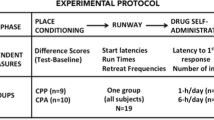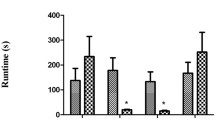Abstract
Male albino rats were trained to traverse a straight alley for a reward of five intravenous injections of cocaine (0.75 mg/kg/injection in a volume of 0.1 ml/injection delivered over 4 s). Animals were tested one trial per day with the following dependent measures assessed on each trial: start latency, running time, the number of retreats, and the location within the alley where each retreat occurred. While start latencies remained short and stable, running times tended to increase over days. This effect was apparently related to a concomitant increase in the number of retreats occurring in the alley (r=0.896). Retreats tended to occur in very close proximity to the goal box, suggesting that animals working for IV cocaine come to exhibit a from of conflict behavior (i.e., retreats) putatively stemming from the drug's well documented rewarding and anxiogenic properties. Consistent with this hypothesis was the demonstration that diazepam (0.5, 1.0, 2.0 mg/kg IP) pretreatment dose-dependently reduced the incidence of retreat behaviors in the alley. In addition, the rewarding efficacy of the cocaine dosing parameters was subsequently confirmed in the runway subjects by conditioned place preference. The present paradigm, therefore, provides a useful method for investigating the anxiogenic effects of self-administered cocaine in laboratory animals.
Similar content being viewed by others
References
Anthony JC, Tien AY, Petronis KR (1989) Epidemiologic evidence on cocaine use and panic attacks. Am J Epidemiol 129:543–549
Brioni JD, Cordoba N, Orsingher OA (1989) Decreased reactivity to the anticonflict effect of diazepam in perinatally undernourished rats. Behav Brain Res 34:159–162
Carden SE, Coons EE (1989) Diazepam modeulates lateral hypothalamic self-stimulation but not stimulation-escape in rats. Brain Res 483:327–334
Carr GD, Fibiger HC, Phillips AG (1989) Conditioned place preference as a measure of drug reward. In: Liebman JM, Cooper SJ (eds) The neuropharmacological basis of reward. Clarendon Press, Oxford, pp 264–319
Corda MG, Biggio G (1986) Proconflict effect of GABA receptor complex antagonists: reversal by diazepam. Neuropharmacology 25:541–544
Costall B, Kelly ME, Naylor RJ, Onaivi ES (1989) The actions of nicotine and cocaine in a mouse model of anxiety. Pharmacol Biochem Behav 33:197–203
Curran HV (1986) Tranquillising memories: a review of the effects of benzodiazepines on human memory. Biol Psychol 23:179–213
Dalterio SL, Wayner MJ, Geller I, Hartmann RJ (1988) Ethanol and diazepam interactions on conflict behavior in rats. Alcohol 5:471–476
deWit H, Wise RA (1977) Blockade of cocaine reinforcement in rats with the dopamine receptor blocker pimozide but not with the noradrenergic blockers phentolamine or phenoxybenzamine. Can J. Psychol 31:195–203
Ettenberg A (1990) Haloperidol prevents the reinstatement of amphetamine-rewarded runway responding in rats. Pharmacol Biochem Behav 36:635–638
Ettenberg A, Camp CH (1986a) A partial reinforcement extinction effect in rats: implications for a dopamine involvement in food reward. Pharmacol Biochem Behav 25:813–821
Ettenberg A, Camp CH (1986b) A partial reinforcement extinction effect in water-reinforced rats intermittently treated with haloperidol. Pharmacol Biochem Behav 25:1231–1235
Ettenberg A, Duvauchelle CL (1988) Haloperidol blocks the conditioned place preferences induced by rewarding brain stimulation in rats. Behav Neurosci 102:687–691
Ettenberg A, Pettit HO, Bloom FE, Koob GF (1982) Heroin and cocaine intravenous self-administration in rats: mediation by separate neural systems. Psychopharmacology 78:204–209
Fontana DJ, Commissaris RJ (1989) Effects of cocaine on conflict behavior in the rat. Life Sci 45:819–827
Gawin FH, Ellinwood EH (1989) Cocaine dependence. Annu Rev Med 40:149–161
Gay GR (1981) You've come a long way baby! Coke time for the new American Lady of the eighties. J Psychoactive Drugs 13:297–318
Geist TD, Ettenberg A (1990) A simple method for studying intravenous drug reinforcement in a runway. Pharmacol Biochem Behav 36:703–706
Goeders NE, McNulty SM, Dworkin SM, Dworkin SI, McAllister, KH (1987) Cocaine-induced changes in benzodiazepine receptors in discrete areas of the rat brain. Neurosci Abstr 13:724
Horvitz JC, Ettenberg A (1988) Haloperidol blocks the response-reinstating effects of food reward: a methodology for separating neuroleptic effects on reinforcement and motor processes. Pharmacol Biochem Behav 31:861–865
Koob GF, Pettit HO, Ettenberg A, Bloom FE (1984) Effects of opiate antagonists and their quaternary derivatives on heroin self-administration in the rat. J Pharmacol Exp Ther 229:481–486
Lesse H, Collins JP (1979) Effects of cocaine on propagation of limbic seizure activity. Pharmacol Biochem Behav 11:689–694
Louie AK, Lannon RA, Ketter TA (1989) Treatment of cocaine-induced panic disorder. Am J Psychiatry 146:40–44
Moldow RL, Fischman AJ (1987) Cocaine induced secretion of ACTH, beta-endorphin, and corticosterone. Peptides 8:819–822
Mucha R, Van der Kooy D, O'Shaughnessy M, Bucenieks P (1982) Drug reinforcement studied by use of place conditioning in rat. Brain Res 243:91–105
Myers JA, Earnest MP (1984) Generallzed seizures and cocaine abuse. Neurology 34:675–676
Nikolic CH, Jovanovic M, Mirkovic L (1984) Syndrome PBC: base cocaine paste abuse (translated title). Psihijatrija-Danas 16:55–63
Nomikos GG, Spyraki C (1988) Cocaine-induced place conditioning: importance of route of administration and other procedural variables. Psychopharmacology 94:119–125
Pettit HO, Ettenberg A, Bloom FE, Koob GF (1984) Destruction of dopamine in the nucleus accumbens selectively attenuates cocaine but not heroin self-administration in rats. Psychopharmacology 84:167–173
Resnick RB, Resnick EB (1984) Cocaine abuse and its treatment. Psychiatr Clin North Am 7:713–728
Rivier C, Vale W (1987) Cocaine stimulates adrenocorticotropin (ACTH) secretion through a corticotropin-releasing factor (CRF)-mediated mechanism. Brain Res 422:403–406
Smith DE (1986) cocaine-alcohol abuse: epidemiological, diagnostic and treatment considerations. J. Psychoactive Drugs 18:117–129
Spotts JV, Shontz FC (1984) Cocaine: phenomenology and implications. Int J Addict 19:119–151
Spyraki C, Fibiger HC, Phillips AG (1982) Attenuation by haloperidol of place preference conditioning using food reinforcement. Psychopharmacology 77:379–382
Spyraki C, Nomikos GG, Varonos DD (1987) Intravenous cocaine-induced place preference: attenuation by haloperidol. Behav Brain Res 26:57–62
Stripling JS, Ellinwood EH (1976) Potentiation of the behavioral and convulsant effects of cocaine by chronic administration in the rat. Pharmacol Biochem Behav 6:571–579
Swerdlow NR, Van der Kooy D, Koob GF, Wenger JR (1983) Cholecystokinin produces conditioned place-aversions, not place-preferences, in food-deprived rats: evidence against involvement in satiety. Life Sci 32:2087–2093
Tarr JE, Macklin M (1987) Cocaine. Pediatr Clin North Am 34:319–331
Thompson T, Pickens R (1970) Stimulant self-administration by animals: some comparisons with opiate self-administration. Fed Proc 29:6–11
Washton AM, Gold MS (1984) Chronic cocaine abuse: evidence for adverse effects on health and functioning. Psychiatr Ann 14:733–739
White N, Sklar L, Amit Z (1977) The reinforcing action of morphine and its paradoxical side effect. Psychopharmacology 52:63–66
Yokel RA, Wise RA (1975) Increased lever-pressing for amphetamine after pimozide in rats: implications for a dopamine theory of reward. Science 187:547–549
Zito KA, Vickers G, Roberts DCS (1985) Disruption of cocaine and heroin self-administration following kainic acid lesions of nucleus accumbens. Pharmacol Biochem Behav 23:1029–1036
Author information
Authors and Affiliations
Rights and permissions
About this article
Cite this article
Ettenberg, A., Geist, T.D. Animal model for investigating the anxiogenic effects of self-administered cocaine. Psychopharmacology 103, 455–461 (1991). https://doi.org/10.1007/BF02244244
Received:
Revised:
Issue Date:
DOI: https://doi.org/10.1007/BF02244244




